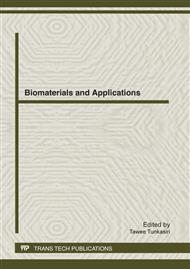p.262
p.266
p.270
p.274
p.278
p.282
p.286
p.290
p.294
Thermal Analysis of Chitosan-Lactate and Chitosan-Aluminum Monostearate Composite System
Abstract:
Chitosan possess many attractive properties for applying as biomaterials. For some application, biomaterial devices have to be sterilized using high temperature, e.g. stream sterilizing process. However, thermal degradation behavior of chitosan has been reported previously. Many researchers have attempted to improve thermal degradation behavior of chitosan by synthesize chitosan derivatives or blending chitosan with other polymers or additives. However, chitosan derivatives found to be less thermal stability than chitosan itself. On the contrary, adding some lipid additive could improve thermal stability of chitosan. In this study, protecting effect of aluminum monostearate (Alst) on thermal stability of chitosan was investigated employing thermal analysis techniques, e.g. thermogravimetry (TG), differential scanning calorimetry (DSC) and hot-stage microscope. Lactic acid solution (2% w/v) was used as solvent for dissolving chitosan. Chitosan solution, named as chtiosan-lactate (CL) and chitosan solution contained 2.5% w/w Alst (CLAlst) were prepared and fabricated into sponges using freeze drying technique. Degradation temperature of CLAlst system investigated from TG was shifted to the higher temperature comparing that of CL which indicated that Alst could improve thermal stability of chitosan after processed as biomaterial. From DSC result, small endothermic peak was observed around 60-70°C for CLAlst whereas that of CL did not exhibit any peak. Melting behavior of the sponges observed under hot-stage microscope was demonstrated that chitosan was decomposed whereas Alst dispersed in chitosan backbone was gradually melted.
Info:
Periodical:
Pages:
278-281
Citation:
Online since:
April 2012
Authors:
Keywords:
Price:
Сopyright:
© 2012 Trans Tech Publications Ltd. All Rights Reserved
Share:
Citation:


